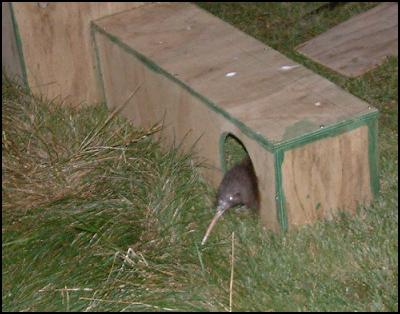Fence Will Create Major New Wildlife Sanctuary at

This young Kiwi was released this week on the fourth tee of the golf course of Julian Roberston’s Kauri Cliffs property in Northland, where extensive work has been done to improve the environment, by US Open champion Michael Campbell.
Media Release January 20, 2006
Fence Will Create Major
New Wildlife Sanctuary at Cape Kidnappers
Two long
established coastal New Zealand sheep stations in the Hawkes
Bay are about to begin a new role.
The owners of Cape Kidnappers and the adjoining Ocean Beach property to the south, have agreed to build a 13.4 kilometre predator proof fence around their properties, turning them into a 2200 ha "mainland island" sanctuary for threatened species.
Julian Robertson (Cape Kidnappers) and Andrew Lowe and Warick Hansen (Ocean Beach) have worked closely with the Department of Conservation and other environmental organisations to assess the viability of the proposal, which would include eradication and monitoring programme to ensure that the populations of stoats, ferrets, rats, hedgehogs, possums, rabbits, feral cats and goats are kept at the lowest possible levels on the seaward side of the specially designed fence.
Environmental consultant John McLennan says that once predator populations are under control, threatened species such as the North Island brown kiwi, tomtits, whitheads and the North Island robin can be reintroduced to the area. They will be followed by threatened seabirds, which no longer nest on the mainland, including several species of petrels, possibly followed by tuatara, which co-habit with petrels and share their burrows. Titi, or muttonbirds, may also be encouraged to set up a shore base near the nationally significant gannet colony that us already on the top of Cape Kidnappers Station.
Meanwhile weeds such as gorse and blackberry are being eliminated on both former sheep stations, fencing is being improved to keep stock out of bush areas, many natives are being planted, and wetlands restored so as to create a desirable environment for flora and fauna what will be one of the largest protected sanctuary areas in New Zealand.
"The fact that the two properties together form a sort of peninsula makes the job a little easier, but it is still a massive project, working in some quite difficult country, to ring fence them," said Mr Robertson. "We have had nothing but support for the concept, which will require regular monitoring programmes to maintain its effectiveness. Over time, we hope both properties will help preserve threatened species, and that we can act in cooperation with other sanctuaries around the country."
Construction of the fence is expected to begin early in the next few months.
ENDS


 Whanganui Regional Museum: Historic Wedding Dress Unveiled, A Piece Of Marton’s Heritage
Whanganui Regional Museum: Historic Wedding Dress Unveiled, A Piece Of Marton’s Heritage Donovan Ryan: Local Runner Takes Out Frontrunner Christchurch Marathon
Donovan Ryan: Local Runner Takes Out Frontrunner Christchurch Marathon University of Auckland: Tributes Flow For Much Loved Pacific Leader Melegalenu’u Ah Sam
University of Auckland: Tributes Flow For Much Loved Pacific Leader Melegalenu’u Ah Sam NZEI: Ministry Of Education Cuts Will Disproportionately Affect Pasifika
NZEI: Ministry Of Education Cuts Will Disproportionately Affect Pasifika Day One Hapai te Haeata: Call To Action For Young Filmmakers Against The Backdrop Of Funding Cuts
Day One Hapai te Haeata: Call To Action For Young Filmmakers Against The Backdrop Of Funding Cuts Toyota New Zealand: Three Races For Top Three To Decide TR86 Title
Toyota New Zealand: Three Races For Top Three To Decide TR86 Title